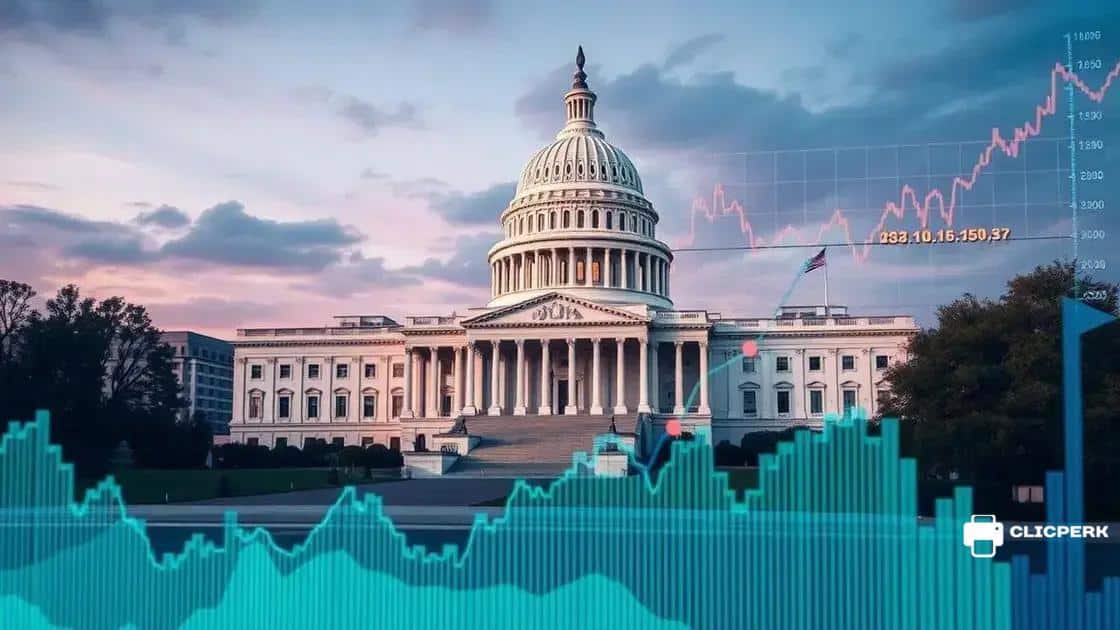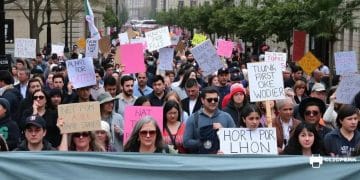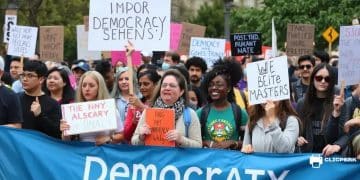Trump administration financial policies on the economy

The Trump administration’s financial policies, including tax cuts and trade changes, aimed to boost economic growth and job creation, while also raising concerns about debt and inequality among the American public.
Trump administration financial policies have created waves throughout the U.S. economy in recent years. From changing tax laws to adjusting trade agreements, the impact is extensive and multifaceted. Curious about how these policies specifically affect everyday life? Let’s dive in.
Overview of Trump administration financial policies
The Trump administration financial policies had significant implications for the U.S. economy. These policies aimed to enhance economic growth, create jobs, and reshape the financial landscape of the nation. Understanding these policies is essential to grasp how they affected various sectors and individuals.
Key Policies Implemented
During its tenure, the Trump administration introduced several bold measures. Tax reforms were at the forefront, and these adjustments aimed to lower rates for individuals and corporations alike.
- Reduction of corporate tax rates from 35% to 21%
- Increased standard deduction for individuals
- Changes to capital gains taxes
- Reform of estate tax laws
These changes significantly impacted both large and small businesses by encouraging investments and spending.
Impact on Economic Growth
Economic growth during the Trump era saw a notable rise. After implementing the Tax Cuts and Jobs Act, there were immediate effects on consumer spending and business investments. Many Americans reported feeling more confident about their financial situations.
This confidence was reflected in a decrease in unemployment rates, hitting record lows by 2019. However, while the economy boomed in certain areas, critics of the administration pointed to increasing national debt and class disparities.
Trade Policies
Another crucial aspect was the administration’s approach to trade, marked by protectionist measures. The imposition of tariffs on countries like China aimed to protect American jobs but sparked tensions that led to trade disputes.
- Tariffs on steel and aluminum imports
- Trade negotiations leading to the USMCA agreement
- Strained relations with international allies
These decisions created waves in global markets and generated significant discussions about the future of trade and relationships with other countries.
Overall, the Trump administration financial policies turned the economic narrative upside down, pushing for growth while navigating the challenges posed by trade and debt. Each decision left a lasting mark that continues to be analyzed and debated in today’s economic environment.
Impact on economic growth and job creation
The impact on economic growth and job creation during the Trump administration was significant and multi-faceted. Policies introduced aimed not only to stimulate the economy but also to reduce unemployment rates and foster a more robust job market. These changes brought about a mix of responses from various sectors.
Economic Growth Metrics
Following the implementation of tax cuts, economic growth in the U.S. saw a noticeable increase. The Gross Domestic Product (GDP) rose, reflecting positive shifts in consumer confidence and business investments.
- The economy experienced quarterly growth rates above 3%.
- Increased spending by businesses on equipment and infrastructure.
- Improvement in consumer confidence levels.
These metrics indicated a thriving economy, fueled by optimism and the desire for expansion.
Job Creation Statistics
Job creation was another focus during this era, with various strategies aimed at putting more Americans back to work. Initiatives aimed to encourage hiring, especially in manufacturing and service sectors.
- Unemployment dropped to historic lows, reaching 3.5% in 2019.
- Manufacturing jobs experienced a revival after decades of decline.
- Tax incentives led to more businesses starting and expanding operations.
Many individuals reported greater opportunities for employment, although critics pointed out challenges in wage growth compared to rising living costs.
The landscape for job creation shifted significantly, predominantly driven by legislation that favored business growth. As companies thrived under the new tax frameworks, they were more inclined to hire, directly affecting millions of Americans.
In summary, the impact on economic growth and job creation during the Trump administration was characterized by both positive advancements and underlying challenges. The effects continue to shape discussions surrounding economic policies today.
Changes in tax regulations and their effects

The changes in tax regulations during the Trump administration brought significant shifts that impacted individuals and businesses alike. These changes were designed to simplify the tax code and stimulate economic growth, but they had wide-ranging effects on the financial landscape.
Major Tax Cuts
One of the most prominent changes was the implementation of the Tax Cuts and Jobs Act in 2017. This legislation led to substantial reductions in tax rates for both corporations and individuals.
- Corporate tax rate was cut from 35% to 21%.
- Individual tax brackets were adjusted to lower rates for many earners.
- The standard deduction was nearly doubled, easing the tax burden for families.
These changes aimed to incentivize spending and investment, which many hoped would lead to economic expansion.
Effects on Individuals and Families
These tax regulations had varied effects on different income groups. While many middle-class families benefited from increased standard deductions, higher earners faced limitations on itemized deductions, particularly for state and local taxes.
- Middle-income families saw an average tax cut.
- Wealthier individuals experienced shifts due to caps on deductions.
- Overall, filing taxes became simpler for many due to reduced complexity.
However, discussions about the long-term sustainability of these tax cuts emerged, especially concerning national debt.
Corporate Sector Reactions
Businesses reacted positively to the reduced corporate tax rates. Many companies announced plans for expansion, increased wages, and investment in workers. However, critics pointed out that the benefits were not evenly distributed.
- Stock buybacks surged, benefiting shareholders.
- Job growth was anticipated, particularly in the manufacturing sector.
- Concerns arose regarding stagnant wages in other sectors.
In essence, the changes in tax regulations stirred a mix of optimism and skepticism as Americans navigated the new tax landscape, leading to discussions that continue to influence fiscal policy debates today.
Trade policies and international relations
The trade policies and international relations during the Trump administration created shifts that reshaped the landscape of global commerce. With a focus on America First, these policies aimed to protect U.S. jobs and industry while addressing trade imbalances.
Key Trade Agreements
One major change was the renegotiation of trade agreements. The administration sought to replace NAFTA with the more recent USMCA, which aimed to create fairer trading conditions.
- Increased protection for U.S. farmers.
- Better terms for the auto industry.
- Stronger labor rights provisions.
These changes were promoted as a way to boost American economic interests and reduce dependency on imports.
Tariffs and Trade Wars
The imposition of tariffs on goods from countries like China was another critical aspect. The administration believed that these tariffs would encourage domestic production while addressing trade deficits.
- Tariffs on steel and aluminum were implemented.
- Additional tariffs on hundreds of billions of dollars of Chinese goods were announced.
- The goal was to pressure trading partners into favorable agreements.
While intended to strengthen U.S. industry, these measures sparked tension and retaliatory tariffs from affected countries, fueling trade wars.
Impact on International Relations
These trade policies significantly impacted international relations. Countries that were subject to tariffs often responded with their own tariffs, leading to strained relationships and economic uncertainty.
- Allies like Canada and Mexico became embroiled in tariff disputes.
- China’s response included tariffs on U.S. goods and threats of further action.
- Negotiations were often contentious, with little resolution at times.
As nations navigated these changes, discussions regarding global trade standards and relationships became more crucial than ever. The trade policies and international relations under Trump highlighted the complexities of balancing national interests with global partnerships, leaving a lasting influence on international trade dynamics.
Public perception of financial decisions
The public perception of financial decisions made during the Trump administration varied widely among different demographics and political affiliations. Understanding how these decisions impacted public opinion can shed light on the broader implications for governance and policy-making.
Initial Reactions to Financial Policies
At the start of the administration, many Americans welcomed the aggressive financial policies. The promised tax cuts and deregulatory actions created optimism, particularly among business owners and investors.
- Tax cuts were seen as a boost for the economy.
- Financial markets responded positively, with stock prices rising.
- Supporters believed these changes would lead to job creation.
However, this optimism was not universal, as critics expressed concerns about the long-term effects of increasing national debt and inequality.
Media Coverage and Narrative
Media coverage played a significant role in shaping public opinion. While financial crime and ethical concerns surrounding deregulation dominated headlines, news outlets often portrayed the administration’s efforts in polarized terms.
- Positive reporting highlighted economic growth and job creation.
- Negative reporting focused on rising debt and disparities.
- The divide in coverage often reflected political biases.
This dual narrative contributed to a national conversation that was often contentious, positioning financial decisions as either successful or reckless.
Public Sentiment Over Time
As time passed, public sentiment evolved. Economic indicators like low unemployment and increased consumer spending brought some reassurance. Yet concerns remained about wealth inequality and access to upward mobility, especially for lower-income Americans.
- Polling data showed fluctuating support based on economic performance.
- Many Americans felt that the tax cuts favored the wealthy.
- Awareness of the effects of tariffs on everyday prices grew.
As individuals struggled to relate financial policy changes to their daily lives, discussions about equity and fairness gained traction. The public perception of financial decisions during this time revealed the complexities of economic policy and its real-world effects on citizens, sparking debates that continue to resonate in contemporary discussions.
FAQ – Frequently Asked Questions about Trump Administration Financial Policies
What were the main tax changes during the Trump administration?
The Trump administration implemented significant tax cuts, lowering corporate tax rates and increasing the standard deduction for individuals.
How did trade policies affect the economy?
Trade policies, including tariffs on imports, aimed to protect U.S. jobs but led to trade tensions and retaliatory measures from other countries.
What impact did these financial policies have on job creation?
The financial policies contributed to job growth, reaching historic low unemployment rates, but also raised concerns about wage stagnation and class disparities.
How did public perception change throughout the Trump administration?
Public perception varied, with initial support for tax cuts and economic growth tempered by concerns regarding debt, inequality, and the implications of trade wars.





